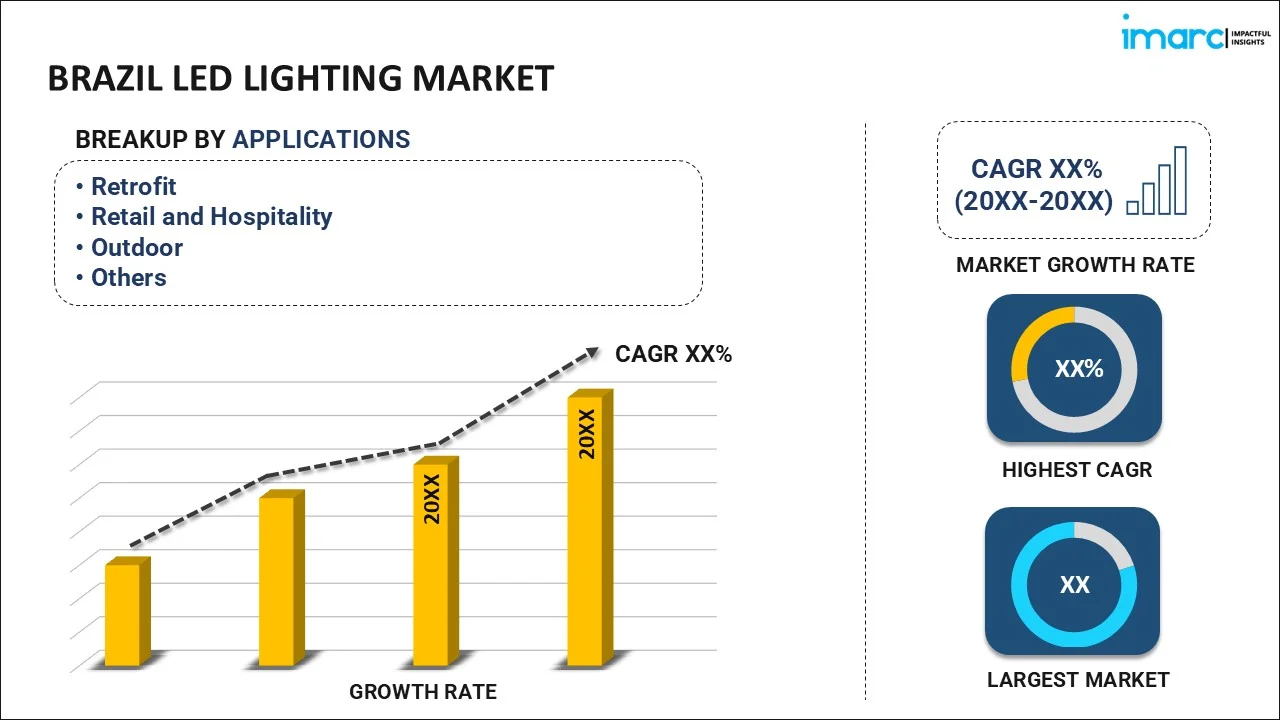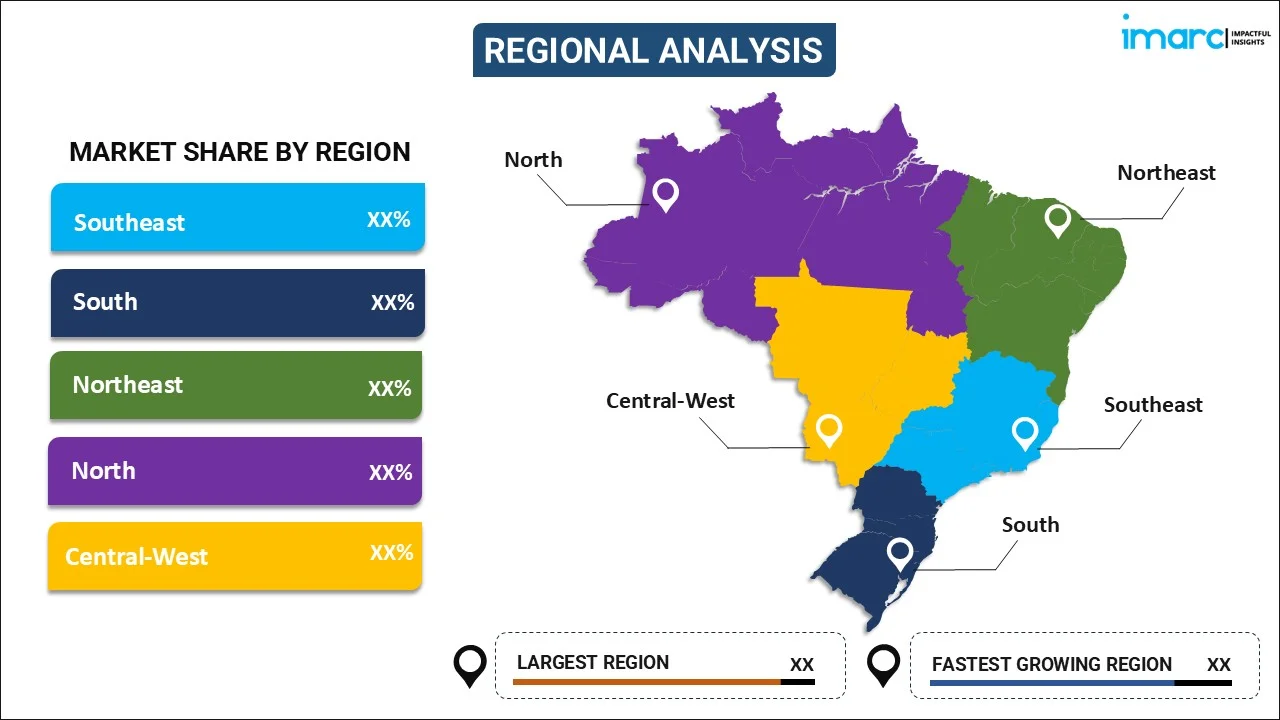
Brazil LED Lighting Market Size, Share, Trends and Forecast by Application, and Region, 2026-2034
Brazil LED Lighting Market Overview:
The Brazil LED lighting market size reached USD 2.4 Billion in 2025. Looking forward, IMARC Group expects the market to reach USD 5.8 Billion by 2034, exhibiting a growth rate (CAGR) of 10.23% during 2026-2034. The market is booming as a result of a growing emphasis on energy efficiency, the implementation of supportive government initiatives, an increased emphasis on cost savings, rising environmental concerns, rapid infrastructure development, and major technology advancements.
|
Report Attribute
|
Key Statistics
|
|---|---|
|
Base Year
|
2025 |
|
Forecast Years
|
2026-2034
|
|
Historical Years
|
2020-2025
|
| Market Size in 2025 | USD 2.4 Billion |
| Market Forecast in 2034 | USD 5.8 Billion |
| Market Growth Rate (2026-2034) | 10.23% |
Brazil LED Lighting Market Trends:
Energy Efficiency
The widespread adoption of LED lighting in Brazil is largely driven by its energy efficiency, which helps reduce electricity costs for residential and commercial users. This is especially crucial in urban areas, where rising population and economic growth are increasing energy demand. For instance, with 87.79% of Brazil’s population living in urban areas in 2023 (World Bank), the need for sustainable and cost-effective lighting solutions is highly imperative, making LED technology a key solution for energy conservation and urban development. Furthermore, LEDs convert a higher percentage of electricity into light rather than heat, making them more efficient in hot climates like Brazil’s, where reducing heat emissions is also a priority. LED lights have been popular among Brazilian customers due to their ability to use less energy while maintaining brightness and quality.
Government Initiatives
Government initiatives and regulations have contributed to the growth of Brazil's LED lighting sector. The Brazilian government has implemented several energy-saving programs and tax incentives to encourage the use of LED technology. One such initiative is the National Energy Efficiency Program, which encourages the use of energy-efficient appliances and lighting. This program has provided financial incentives to businesses and households that adopt energy-saving technologies, including LEDs. Additionally, the government has imposed stricter regulations on the production and sale of less energy-efficient lighting products, such as incandescent bulbs, phasing them out of the market in favor of more efficient alternatives like LEDs. For instance, PotencializEE is a project promoting energy efficiency in Brazilian industries, particularly for small and medium-sized enterprises (SMEs). With a €24.3 million budget, it focuses on São Paulo and expands to other regions. The project provides financial support, training, and policy improvements to boost energy efficiency investments. It has reduced over 370,000 million tonnes of CO2e and supports 1,000 SMEs directly. It also leverages government resources to benefit 10,000 MSMEs nationwide as part of Brazil’s green industrialization efforts.
Technological Advancements
Technological advancements in LED lighting have been a key driver of market growth in Brazil. Significant innovations in LED technology have resulted in improvements in light quality, energy efficiency, and functionality. When compared to previous lighting generations, LED systems are more adaptable, providing capabilities like dimming, remote control, and smart integration. These innovations have made LEDs more attractive to both commercial and residential users. Smart LED lighting systems, which can be integrated with the Internet of Things (IoT) platforms, allow users to control lighting remotely via smartphones or central management systems. This has been particularly appealing to businesses and large infrastructure projects aiming to implement energy management solutions. For instance, in November 2024, Cree LED introduced CV28D LEDs with FusionBeam Technology, a breakthrough in LED signage that combines through-hole and surface-mount (SMD) technologies. This innovation enhances clarity, contrast, and resolution, allowing signs to display icons, photos, logos, and video, a major upgrade from traditional text-based displays.
Brazil LED Lighting Market Segmentation:
IMARC Group provides an analysis of the key trends in each segment of the market, along with forecasts at the region/country level for 2026-2034. Our report has categorized the market based on application.
Application Insights:

- Retrofit
- Retail and Hospitality
- Outdoor
- Offices
- Architectural
- Homes
- Industrial
A detailed breakup and analysis of the market based on the application have provided have also been provided in the report. This includes retrofit, retail and hospitality, outdoor, offices, architectural, homes, and industrial.
Regional Insights:

- Southeast
- South
- Northeast
- North
- Central-West
The report has also provided a comprehensive analysis of all the major regional markets, which include Southeast, South, Northeast, North, and Central-West.
Competitive Landscape:
The market research report has also provided a comprehensive analysis of the competitive landscape. Competitive analysis such as market structure, key player positioning, top winning strategies, competitive dashboard, and company evaluation quadrant has been covered in the report. Also, detailed profiles of all major companies have been provided.
Brazil LED Lighting Market News:
- In May 2024, ams OSRAM, with a strong foothold in Brazil, introduced the OSCONIQ™ P 3737, a high-power horticultural LED with an industry-leading 83.2% wall plug efficiency in Hyper Red. It enhances crop yields, reduces energy costs, and extends LED lifespan to 102,000 hours. The LED is ideal for greenhouse top lighting, interlighting, vertical farming, and sole-source lighting.
- In December 2024, Cree LED, a Penguin Solutions brand, and Daktronics entered a multi-year, global patent license agreement effective December 2024. The agreement grants Daktronics access to Cree LED’s patented technology for LED displays, ensuring legal protection against patent claims during the contract period.
- In 2024, Signify, formerly known as Philips Lighting, launched the Philips GreenPower LED Toplighting Force 2.0 (TLF 2.0), a cutting-edge horticultural lighting system designed to enhance crop yield and energy efficiency. It features high light output (up to 5150 µmol/s), dynamic color control, and wireless integration for precise light spectrum adjustments. The system improves light uniformity, reduces installation and operational costs, and supports sustainable farming. With up to 50% energy savings, it helps growers optimize crop growth while minimizing environmental impact.
Brazil LED Lighting Market Report Coverage:
| Report Features | Details |
|---|---|
| Base Year of the Analysis | 2025 |
| Historical Period | 2020-2025 |
| Forecast Period | 2026-2034 |
| Units | Billion USD |
| Scope of the Report |
Exploration of Historical Trends and Market Outlook, Industry Catalysts and Challenges, Segment-Wise Historical and Future Market Assessment:
|
| Applications Covered | Retrofit, Retail and Hospitality, Outdoor, Offices, Architectural, Homes, Industrial |
| Regions Covered | Southeast, South, Northeast, North, Central-West |
| Customization Scope | 10% Free Customization |
| Post-Sale Analyst Support | 10-12 Weeks |
| Delivery Format | PDF and Excel through Email (We can also provide the editable version of the report in PPT/Word format on special request) |
Key Questions Answered in This Report:
- How has the Brazil LED lighting market performed so far and how will it perform in the coming years?
- What is the breakup of the Brazil LED lighting market on the basis of application?
- What are the various stages in the value chain of the Brazil LED lighting market?
- What are the key driving factors and challenges in the Brazil LED lighting market?
- What is the structure of the Brazil LED lighting market and who are the key players?
- What is the degree of competition in the Brazil LED lighting market?
Key Benefits for Stakeholders:
- IMARC’s industry report offers a comprehensive quantitative analysis of various market segments, historical and current market trends, market forecasts, and dynamics of the Brazil LED lighting market from 2020-2034.
- The research report provides the latest information on the market drivers, challenges, and opportunities in the Brazil LED lighting market.
- Porter's five forces analysis assist stakeholders in assessing the impact of new entrants, competitive rivalry, supplier power, buyer power, and the threat of substitution. It helps stakeholders to analyze the level of competition within the Brazil LED lighting industry and its attractiveness.
- Competitive landscape allows stakeholders to understand their competitive environment and provides an insight into the current positions of key players in the market.
Need more help?
- Speak to our experienced analysts for insights on the current market scenarios.
- Include additional segments and countries to customize the report as per your requirement.
- Gain an unparalleled competitive advantage in your domain by understanding how to utilize the report and positively impacting your operations and revenue.
- For further assistance, please connect with our analysts.
 Request Customization
Request Customization
 Speak to an Analyst
Speak to an Analyst
 Request Brochure
Request Brochure
 Inquire Before Buying
Inquire Before Buying




.webp)




.webp)












